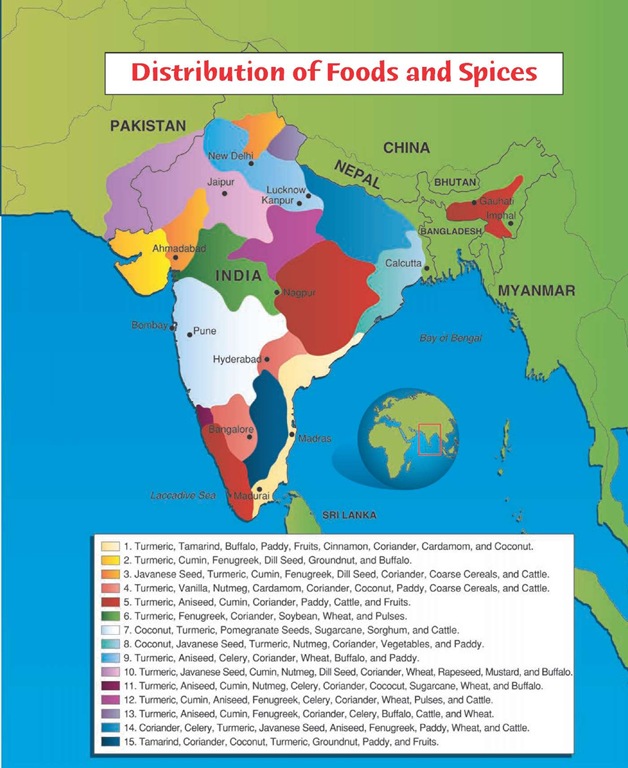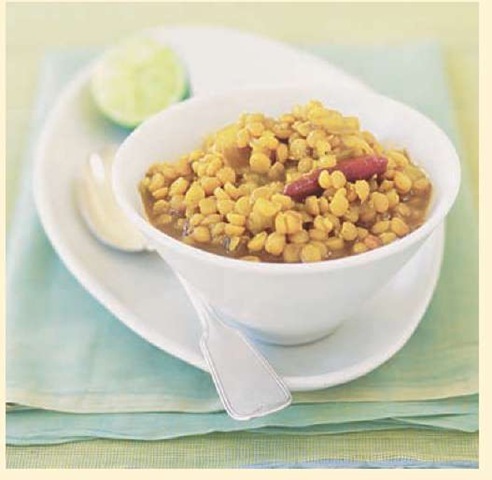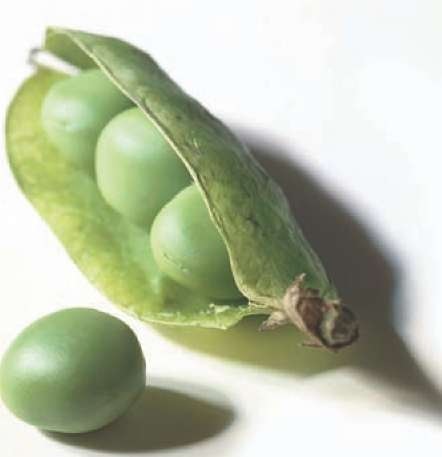Indian cooking is colorful, fragrant, and delicious. It depends on a wide array of spices, legumes, and grains for its distinct character.
An Ancient Treasure
India is the world’s chief supplier of spices and has been for at least thirty-six hundred years. These fragrant and flavorful plant substances, which often have been more prized than jewels, have drawn people from all over the world to India throughout history.
Unlike spice seekers from other nations, Indians have always had access to a wide array of different spices. Some of the most popular spices include mint, bright orange turmeric, pungent cumin, sweet and refreshing cardamom, parsley-like coriander, bitter-tasting kari (cah-ree), cinnamon, and mustard seeds.
Indian chefs have been using these and other delicious spices to preserve, color, flavor, and perfume their food for thousands of years. Indian cuisine would not be the same without them.
An Artful Combination
Indians use spices the way artists use paint, blending them together in hundreds of different combinations and proportions. For a dish to be considered well cooked, no single spice should ever dominate. Instead there must be a perfect balance of ingredients, with each dish having its own distinctive taste, color, and perfume. This means that cooks need to understand the characteristics of each spice and how they mix together. Chef Mridula Baljekar explains: "Spices are the heart and soul of Indian cooking. Knowing how to use the spices is the key that unlocks the secrets of alluring aromas and magical flavors of classic Indian cuisine."1 Indian cooks blend spices in a number of ways. They create a masala (mah-saah-laah), a general term that refers to any combination of ground spices. They make masala by grinding different spices together into a powder. This may be done in a stone dish known as a mortar with a small, wooden, clublike tool called a pestle. A food processor can also be used to save time. Garam masala (gah-rahm mah-saah-laah), a favorite spice mixture, is a specific blend of up to fifteen spices that is widely used in Indian cooking. It features cinnamon, black pepper, cloves, cardamom, and other spices. It is dark and zesty.
Spices are also used whole. Roots, pods, seeds, and leaves are fried for less than a minute in hot oil or ghee (gee). Ghee is a type of butter in which all the milk solids have been removed. Incredibly fragrant, the spiced or tempered oil is used as a basis for hundreds of different sauces.
Rice and Grains
Sauces are often served over rice, a staple of the Indian diet and an important part of Indian culture. Rice symbolizes good fortune in India, which is why rice porridge is the first solid food fed to babies. It is also the most important crop in India, with one-fourth of all cultivated land planted with it.
Although many varieties of rice are grown, basmati (bas-maah-tee) rice is the most popular. It is known for its smooth, rich taste and fresh aroma. Basmati literally means "the queen of perfumes" in Hindi, one of the most common languages spoken in India. Indians have many uses for basmati rice. It is boiled and topped with a spicy sauce filled with meat or vegetables. It can also be stir-fried with spices, used in puddings, puffed into a popcorn-like snack, or cooked in aromatic casseroles.
Indians eat about 41/2 pounds (2 kg) of rice a week. Before cooking it, they carefully rinse the rice. This removes impurities and excess starch and keeps the grains from sticking together. Then the rice is soaked for at least an hour before it is boiled. Soaking whitens the rice and helps the grains absorb the flavor of the spicy sauces that will be poured over them. According to authors Martin Hughes, Sheema Mookherjee, and Richard Delacy, the end result is, "white, long, and silky."2
Rice with Cumin
This is a wonderfully scented rice dish. It uses bas-mati rice, but any long-grain rice can be substituted. Cumin seeds are sold in the spice section of supermarkets.
Ingredients
1 tablespoon vegetable oil for frying
1 teaspoon cumin seeds 12 teaspoon black pepper
2 cups basmati or other long grain rice 4 cups water
52 teaspoon salt
Instructions
1. Heat the oil in a large saucepan over medium heat. Add the cumin and pepper. Stir-fry for about 45 seconds. Add the rice and stir-fry for one minute.
2. Add the water and salt. Bring the rice to a boil. Reduce heat to low, cover the pan, and simmer until the water is absorbed and the rice is tender, about ten minutes.
3. Remove the rice from heat. Leave the rice covered for about five minutes. Uncover carefully, because hot steam will escape. Fluff with a fork and serve.
A rice vendor sells packets of Basmati rice.
Indian flat breads called rotis cook on a hot griddle outdoors.
Wonderful Breads
Although rice is eaten at every meal in southern India and in great quantities in northern India, flat breads known as rotis (ro-tees) are the core of northern meals. Rotis are also popular in the rest of the nation. Roti originated centuries ago as a portable food that farmers and shepherds could dine on when they were out in the fields. Today Indians use rotis like edible spoons to scoop up saucy dishes, meat, and vegetables.
Rotis are made without yeast from nutrient-rich whole-wheat flour, which is mixed with water and kneaded to form a thin dough. The dough is divided into tennis ball-size portions, rolled into almost perfect circles, and cooked on a hot cast-iron griddle known as a tawa (tah-waah).
Cooks make a wide variety of rotis, but the most common is chapati (chah-paah-tee), a soft flat bread that balloons out as it cooks. Other favorites include pooris (poo-rees), which are deep-fried chapatis, and paranthas (pah-rahn-thahs), which have a pastry-like texture. Many Indian cooks make fresh roti for every meal. Traditionally the woman of the house makes the bread as the family eats. When the roti is done, she brushes it with butter to keep it soft and transfers it from the griddle to the table. "This is simple . . . home cooking," explains a chef at the Indian Foods Company. "I cannot go for many days without my roti."3
Colorful Legumes
Legumes are another essential part of the Indian diet. Legumes such as lentils, beans, and peas are eaten at least once a day. They are usually flavored and scented with spices and served over rice, or with roti and a vegetable. Since they are loaded with vitamins, minerals, protein and fiber they are quite nutritious. This may be why an Indian proverb says that legumes and roti are all an Indian needs to survive.
Lentil Dal
This simple dal recipe uses lentils. Yellow split peas can be substituted.
Ingredients
1 cup dried lentils
2 cups water
12 teaspoon salt
J2 teaspoon turmeric
2 teaspoon cayenne pepper
1 onion, finely chopped
1 tablespoon minced garlic
1 tablespoon vegetable oil or butter for frying
Instructions
1. Combine lentils, water, salt, and turmeric in a saucepan and bring to a boil. Lower the heat, cover the pan, and simmer until the lentils are cooked and much of the water is absorbed, about twenty minutes. The mixture should be soft and thick when done. If the mixture starts to stick to the pot during cooking, add more water.
2. Heat oil in a frying pan. Add onions, garlic, and cayenne pepper. Fry over low heat until the onions are translucent.
3. Stir the onion mixture into the lentils. Serve with rice.
Vegetables
Indians eat a lot of vegetables. Vegetables are served at almost every meal and are cooked in a wide variety of ways. They are often the main ingredients in spicy sauce dishes. They are roasted in a tandoor, made into fritters, threaded on kabobs, stir-fried, or mashed.
Some Indian vegetables are familiar to Westerners, while others are not. Potatoes, onions, spinach, eggplant, cabbage, cauliflower, and thin, sweet carrots are very popular. White pumpkins, which are cooked in a spicy sauce, are less familiar. Other unusual vegetables include purple and white yams, various edible gourds, the roots of the lotus flower, and white radishes. Plantains, large, green, banana-like fruits, are fried and sprinkled with spices.
Indian cooks use over 60 different types of legumes. These include tiny yellow split peas; black, yellow, and pink lentils; and tan chickpeas. One of the favorite ways of using legumes is in dal (dahl), a delicious stewlike dish. Each cook has his or her own dal recipes, so there are countless variations. Depending on the cook, dal can contain just one type of legume or a few. It can be thick and chunky, or the lentils may be mashed so that the dal is thin and velvety smooth. But what gives dal its special taste and aroma are the spices that flavor it.
To make dal, cooks soak the legumes overnight to soften them. Then they simmer them for hours. When the legumes are tender, selected spices are cooked in hot oil or ghee and added to the legumes right before they are served. This gives the legumes, which are otherwise bland, a savory flavor and a mouthwatering aroma. Popular combinations include pink lentils spiced with cumin, pepper, and chili powder, or yellow split peas flavored with mashed garlic, ginger, and cinnamon.
Pea Pod
Mint is often added to the stew. And sometimes yogurt is mixed into dal to give it a creamy texture. One thing is certain: No matter the ingredients, Indians love dal. "There is something wonderfully warm and tasty about . . . dal," explains chef Suvir Saran. "I want [it] when I have a craving for something simple and homey, but still savory."4
Indian cooking is, indeed, warm and tasty. Indian chefs artfully combine brightly colored legumes, richly perfumed spices, and deliciously satisfying grains to create dishes that are uniquely Indian.







